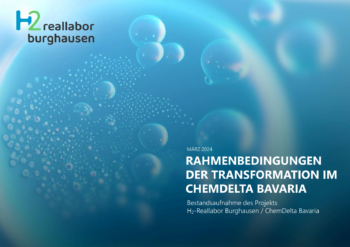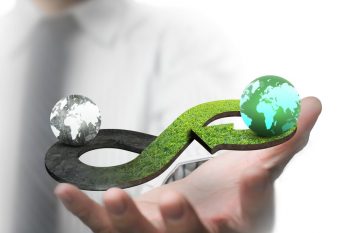Series of articles Carbon Management: Which framework conditions need to be considered?
With the European climate neutrality targets for 2050 firmly in place, carbon management is moving into the focus of sustainable environmental practices. The challenge is not only to reduce emissions, but also to effectively manage unavoidable emissions. This requires the use of carbon capture technologies that enable either underground storage (Carbon Capture and Storage – CCS) or integration into a closed carbon cycle (Carbon Capture and Utilization – CCU). This series of articles provides an overview of carbon capture technologies, possible utilization of CO2, storage methods, transportation options and political efforts in the context of carbon management.
Contents of the article series
- Explanation of terms and basics
- How are captured emissions accounted for?
- How can CO2 be captured?
- CCU – How can CO2 be utilised?
- CCS – How can CO2 be stored?
- How can CO2 be transported?
- What framework conditions need to be considered?
European Perspective
On February 6, 2024, the European Commission presented its strategy for industrial CO2 management [3]. This is in line with the EU’s targets of reducing net emissions by 90% by 2040 compared to 1990 and becoming climate neutral by 2050. Accordingly, at least 50 million tons of CO2 per year are to be captured by 2030, approx. 280 million tons per year by 2040 and approx. 450 million tons of CO2 per year by 2050. CO2 is also to be extracted directly from the atmosphere using Direct Air Capture (DAC). By 2040, DAC should account for around 25 % of captured emissions (see Figure 1).

The presented EU strategy considers all steps of the CO2 value chain: capture, transportation, storage and use. The aim is to prepare and create an EU internal market for CO2 management. The four most important measures and instruments for this are:
- Expansion of CO2 transport infrastructure:
including the development of a legal framework, a market structure and an infrastructure planning mechanism, as well as the establishment of minimum standards for CO2 - Strong increase in CO2 capture and storage:
This is to be done, for example, by setting up a platform for the (voluntary) bundling of demand and supply of the various CO2 players, as well as an investment atlas with potential storage sites. - Promotion of CO2 removal:
To this end, strategies are being developed to promote CO2 removal in industry as well as the stimulation of research and innovation, e.g. through the Innovation Fund, the Connecting Europe Facility (CEF) or Horizon Europe. - Promotion of CO2 utilisation:
The aim is to increase the use of sustainable carbon as a raw material in industry and to establish rules for recording industrial carbon management activities.
German Perspective
On 26 February, the Federal Government’s key points for a carbon management strategy [4] were presented. This includes framework conditions for the CCS/CCU ramp-up in line with Germany’s GHG reduction targets for climate neutrality by 2045.
In the area of electricity generation, priority remains on accelerating the expansion of renewable energies. In the case of the generation of electricity from gaseous energy sources or biomass (BECCS), CCS/CCU is to be made possible in the sense of openness to technology, but is not to be subsidised for power plants with fossil fuels. This applies in particular to the flexible H2-ready natural gas power plants required by the intended capacity mechanism. Justified by the coal phase-out, coal-fired power plants are not to be given access to CO2 pipelines.
Government support for CCS/CCU focuses on emissions that are difficult or unavoidable. These include, in particular, the lime and cement industry, as well as thermal waste treatment. CCS/CCU should be possible for other industrial processes as long as a conversion to H2 or electrification is not yet cost-effective in the foreseeable future. Climate protection contracts are available as funding instruments, in which CCS/CCU for the capture of process emissions can also be classified as eligible for funding in the future. The Federal Funding Guideline for Industry & Climate Protection (FRL BIK) also provides for the introduction of a funding module for investment, innovation, research and development projects for CCS/CCU in sectors with CO2 emissions that are predominantly difficult to avoid. Development projects and facilities for achieving negative emissions are also to be supported.
An update of the Carbon Dioxide Storage Act (KSpG) is intended to enable the construction of CO2 pipelines under private ownership. In the course of this, the law will be renamed the Carbon Dioxide Storage and Transport Act (KSpGT). Pipelines are the most cost-effective option for large quantities of CO2. Further framework conditions on network charges and access conditions for such an infrastructure have yet to be determined.
The ratification of the corresponding amendments to the London Protocol [1] as well as amendments to the High Seas Contribution Act enable CO2 to be exported for offshore storage. In the German exclusive economic zone (AWZ) or the continental shelf, the exploration of offshore storage sites is also to be made possible in accordance with the polluter pays principle. For the development, a suitable location must be proven, taking into account safety standards and ecological criteria. These include, for example, minimizing environmental impacts, high safety and monitoring standards for CCS, as well as environmental impact assessments. Marine protected areas are explicitly excluded from CO2 injection.
Onshore CO2 storage is ruled out for the time being. However, the possibility of an opt-in regulation for individual federal states will be considered on request in the further strategy process.
In addition, the Federal Government has published key points of the long-term strategy for negative emissions to deal with unavoidable residual emissions (LNe) [5]. This serves as a basis for setting targets for negative emissions in the years 2035, 2040 and 2045. In addition to reducing GHG emissions, as the highest priority of climate protection measures, CO2 removal from the atmosphere and permanent storage are necessary to compensate for remaining, unavoidable residual emissions in order to achieve net greenhouse gas neutrality. This is further supported by the IPCC’s current analyses of the global CO2 budget, which assume that the budget will be exceeded and thus require net negative emissions in the long term [6]. The European Climate Law also aims for net negative emissions from 2050 onwards.
Negative emissions are caused by human activities (including land use) in which CO2 is removed from the atmosphere and permanently stored geologically, terrestrially or oceanically. These measures are also known as Carbon Dioxide Removal (CDR). Thus, the LNe does not consider the capture of fossil emissions directly at the emission sources with subsequent storage (CCS), as these do not generate negative emissions. However, CCS in combination with Direct Air Capture (DACCS) or the capture and storage of biogenic emissions (BECCS) are part of the strategy.
The strategy aims to create a common understanding of the role of CO2 removal in climate protection. To this end, it is divided into five sub-areas:
- Targets for the expansion of negative emissions:
To determine the level of negative emissions already provisioned, the expected needs and the potential based on robust scenarios to offset unavoidable residual emissions for net GHG neutrality in 2045 and to achieve net-negative emissions from 2050 onwards. It looks at the period up to 2060 to look at the long-term role of negative emissions. From this, target values for technical sinks in the years 2035, 2040 and 2045 are derived, as well as a target for net negative emissions in 2060 (1.5°C-compliant). - Evaluation of methods and technologies:
This is followed by the timely and needs-based development and scaling of methods and technologies to achieve negative emissions. These are to be evaluated comprehensively and systematically in the LNe. The central benchmark is the climate protection effect of CO2 removal, especially with regard to CO2 storage time and reversibility. The extent to which non-permanent CO2 removals can play a complementary role is being examined. - Governance and legal framework:
The third sub-area contains approaches for a coherent governance framework to be developed, which identifies current legal obstacles and makes proposals for reliable monitoring and certification of negative emissions. - Economic incentives and market frameworks:
Establish an appropriate market framework for economic incentives to develop negative emission technologies. This includes, among other things, the examination of proposals for the review process of the EU ETS as well as suitable funding instruments. - Research and development:
Research and development to bring the relevant technologies from the development phase to market maturity. This includes testing and demonstration projects, including field experiments.
In particular, the LNe looks at the following methods and technologies for negative emissions:
- Forests and the potential of first afforestation
- Peatlands
- Soil management
- Biomass production
- Marine biomass
- Material use of biomass
- Biochar
- Bio-Energy with Carbon Capture, Utilization and Storage (BECCU/S)
- Direct CO2 capture from the air and storage/utilization (Direct Air Carbon Capture, Utilisation and Storage/Sequestration, DACCU/S)
- CO2 utilization, binding in products (CCU)
- Accelerated weathering (carbonation)
Selected federal states
At the state level, there are currently only a few strategies for carbon management. So far, only NRW has presented a carbon management strategy [7]. For Bavaria, the FfE has prepared a study on the CO2 infrastructure requirements on behalf of the Association of Bavarian Industry e.V. [2].
Further information
Literatur
[1] Convention on the Prevention of Marine Pollution by Dumping of Wastes and Other Matter (London Convention). Ausgefertigt am 1972, Version vom 2006; London: International Maritime Organization, 2006.
[2] Pleier A., Kracht H., Guminski A.: Analyse CO2-Infrastrukturbedarf in Bayern – Eine vbw Studie, erstellt von der FfE – Forschungsgesellschaft für Energiewirtschaft mbH. München: FfE GmbH, 2023.
[3] Towards an ambitious Industrial Carbon Management for the EU. Strasbourg: European Commission, 2024.
[4] Eckpunkte der Bundesregierung für eine Carbon Management-Strategie. Berlin: Bundesministerium für Wirtschaft und Klimaschutz (BMWK), 2024.
[5] Langfriststrategie Negativemissionen zum Umgang mit unvermeidbaren Restemissionen (LNe) – Eckpunkte. Berlin: Bundesministerium für Wirtschaft und Klimaschutz (BMWK), 2024.
[6] Synthesis Report of the IPCC Sixth Assessment Report (AR6) – Longer Report. Genf: Intergovernmental Panel on Climate Change (IPCC), 2023.
[7] Ministerium für Wirtschaft, Innovation, Digitalisierung und Energie des Landes Nordrhein-Westfalen: Carbon Management Strategie Nordrhein-Westfalen – Kohlenstoff kann Klimaschutz. Düsseldorf: Ministerium für Wirtschaft, Innovation, Digitalisierung und Energie des Landes Nordrhein-Westfalen, 2021.

